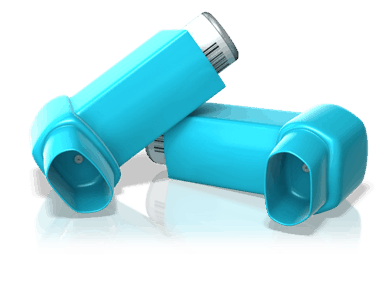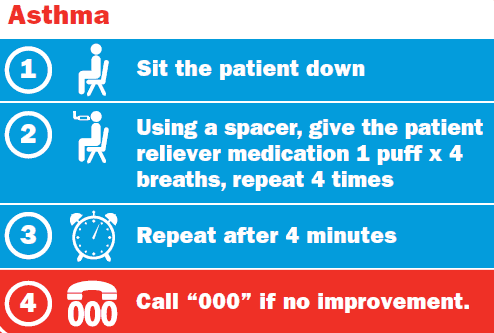FIRST AID ESSENTIALS
ASTHMA
Asthma is a disorder of the smaller airways of the lungs. People with asthma have sensitive airways which can narrow when exposed to certain ‘triggers’, leading to difficulty in breathing.
Three main factors cause the airways to narrow:
- The muscle around the airway tightens (bronchoconstriction).
- The inside lining of the airways becomes swollen (inflammation).
- Extra mucus (sticky fluid) may be produced.
Signs and symptoms
Asthma can be recognised by the following symptoms and signs:
- A dry, irritating, persistent cough, particularly at night, early morning, with exercise or activity
- Chest tightness
- Shortness of breath
- Wheeze
Signs and symptoms of a severe asthma attack include some or all of the following:
- Gasping for breath
- Severe chest tightness
- Inability to speak more than one or two words per breath
- Feeling distressed and anxious
- Little or no improvement after using “reliever” medication
- ‘Sucking in’ of the throat and rib muscles, use of shoulder muscles or bracing with arms to help breathing
- Blue discolouration around the lips (can be hard to see if skin colour also changes)
- Pale and sweaty skin
- Symptoms rapidly getting worse or using reliever more than every two hours.
As well as the above symptoms, young children appear restless, unable to settle or become drowsy. A child may also ‘suck’ in muscles around the ribs and may have problems eating or drinking due to shortness of breath. A child also may have severe coughing and vomiting.
An asthma attack can take anything from a few minutes to a few days to develop
NOTE: Most fatal cases of food-induced anaphylaxis occur in those with asthma. In patients with asthma known to be at risk from anaphylaxis, if it is uncertain whether the patient is suffering from asthma or anaphylaxis, it is appropriate to administer an adrenaline autoinjector first, followed by asthma reliever medication. No harm is likely to occur by doing so in a patient having asthma without anaphylaxis.
Management
If a victim has any signs of a severe asthma attack:
- Call an ambulance straight away; and
- Follow the Asthma First Aid Plan while waiting for the ambulance to arrive.

What is a spacer?
A spacer is a holding chamber shaped like a football or tube. It makes it easier to take asthma or COPD medication from the type of puffer called an MDI (metered-dose inhaler).
Spacers help the medication get straight to where it’s needed in the lungs, with less medication ending up in the mouth and throat where it can lead to irritation or mild infections. A spacer can also make it easier to coordinate breathing in and pressing the puffer when self-administering.
Quick response guide

